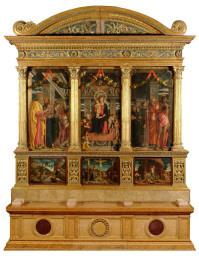To help the Louvre celebrate Italian Renaissance master Andrea Mantegna, Britain's Queen Elizabeth II has agreed that one of his works can leave Hampton Court for the first time in over 350 years.
The magnificent 1486 Triumphs of Caesar cycle will be one of the key works on show at the Paris museum, which is hosting the largest Mantegna retrospective ever seen in France next month.
The masterpiece consists of nine tempera paintings depicting Julius Caesar in a lavish celebratory military parade as he shows off the spoils and prisoners of war to an adoring public.
The paintings have not moved since they entered the British royal collection in 1631.
For a massive show in Mantua celebrating the 500th anniversary of the painter's death two years ago, the cycle's nine tempera paintings were instead recreated virtually in a state-of-the-art computer gallery.
The Triumphs will go on show along with around 190 paintings, prints, drawings, manuscripts and sculptures on loan from museums in France and across the world for the Louvre exhibition.
Also specially reunited for the show will be three paintings that make up the predella - or altar step - of Mantegna's monumental altarpiece (1456-59) from the Church of St Zeno in Verona.
The Resurrection and The Agony in the Garden, both now conserved in the Musee des Beaux-Arts in Tours, and the Louvre's own Crucifixion, were stripped from the altar by the French in 1797 during the Napoleonic Wars, along with the main triptych.
While the triptych was returned to the altarpiece in the Verona church, the three predella paintings stayed in France and were replaced with copies.
The altarpiece is currently undergoing restoration but will be back on display in the church in May 2009.
MANTEGNA'S ILLUSIONIST LEGACY.
Mantegna (1431-1506), who grew up and first worked in Padua, is regarded as northern Italy's first fully-fledged Renaissance painter.
He is credited with paving the way for later Renaissance and Baroque artists through his use of illusionism and play with perspective that presented subjects from unusual angles.
Arguably his greatest masterpiece is the 1474 Bridal Chamber, in which he painted the walls and ceiling of a small room in the Palazzo Ducale in Mantua to resemble an open-air pavilion - the first foray into illusionist ceiling painting since Roman times.
The room appears to be open to the sky, with servants and cherubs leaning over a balustrade, a style that was to become a common feature in Baroque art.
Mantegna is also famed for his etchings, through which he is credited with influencing German artists such as Albrecht Durer.
Married to the sister of two other Renaissance masters, Giovanni and Gentile Bellini, Mantegna moved to Mantua in the early 1460s to work for the Gonzaga family.
He remained in their service for the rest of his life, creating some of his best works and ensuring the Gonzaga court rivalled those of Florence and Milan.
Mantegna, 1431-1506 will run at the Louvre in Paris from September 26 this year to January 5, 2009.









